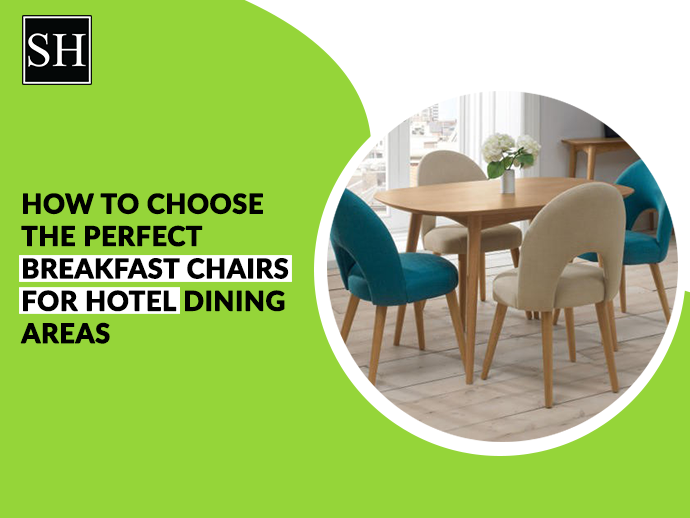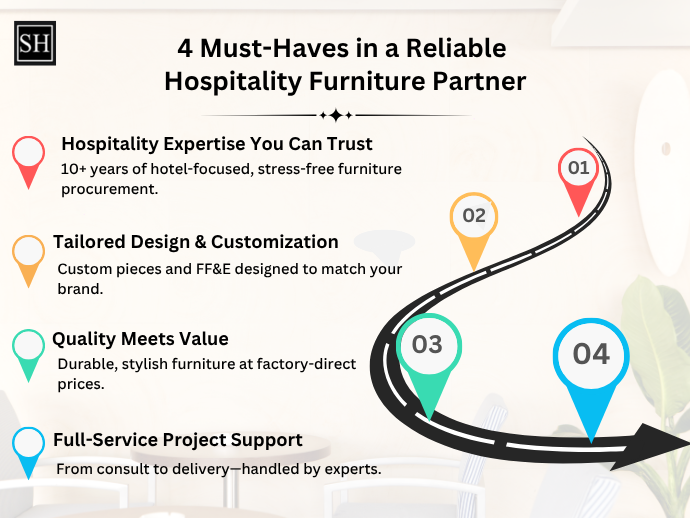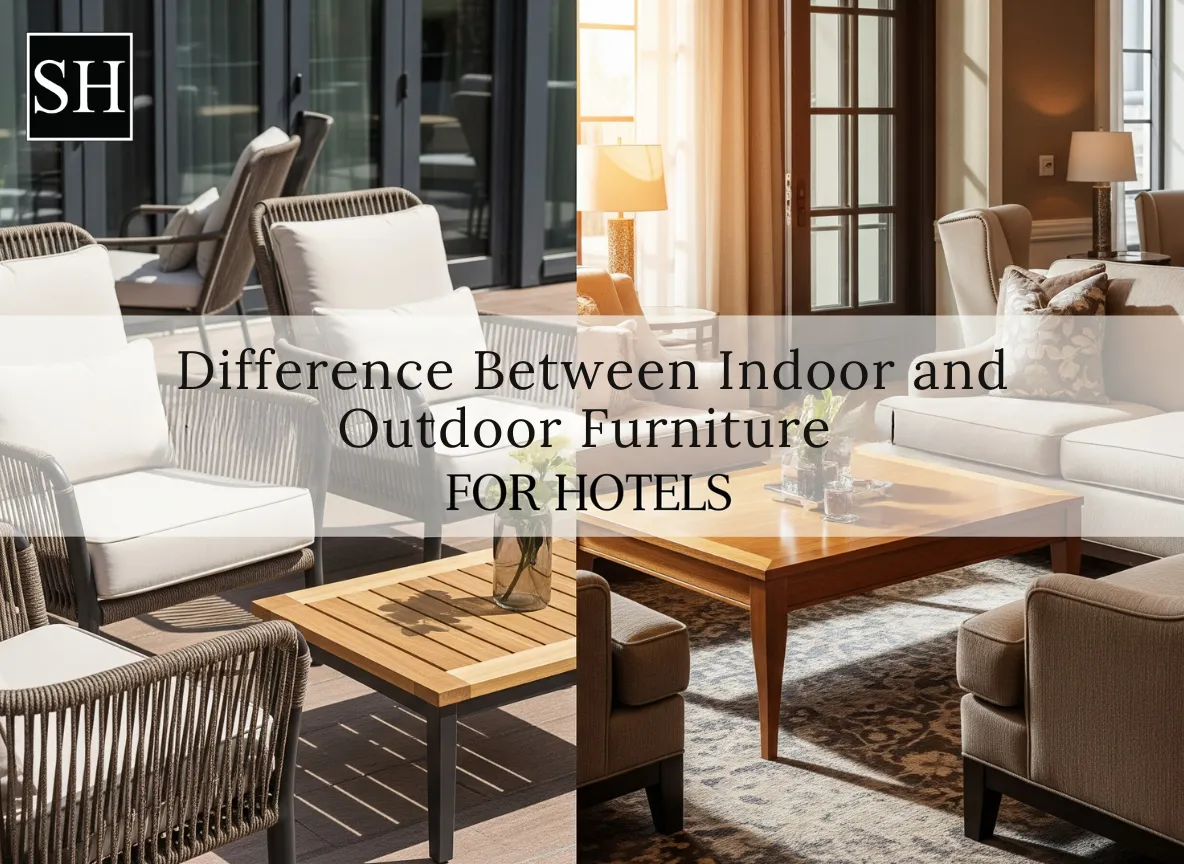
How to Choose the Perfect Breakfast Chairs for Hotel Dining Areas
Hotel dining area breakfast chairs – they may appear to be a background element, but their effect on the morning experience of a guest is surprisingly great. It's not merely about the croissants or the coffee; where guests sit to begin their day affects their comfort, impression of your brand, and overall satisfaction.
These chairs have to balance carefully, they have to be beautiful, Comfortable breakfast room furniture must also be long-lasting, and blend into your dining area's layout and design. Whether creating an intimate boutique breakfast area or expansive luxury buffet, the proper chairs surreptitiously enhance your hotel's ambiance and hold up your guests – both literally and metaphorically.
This guide offers a pragmatic step-by-step approach to the key things to consider when choosing breakfast chairs, including custom hotel seating solutions. We'll concentrate on what really counts so you can make informed decisions that enhance the guest experience, encourage lingering, and boost your hotel's reputation.
First Impressions: The Silent Impact of Seating
Breakfast chairs say more than you realize. They establish the tone before a single plate hits the table. A cramped or aesthetically discordant chair can quietly subtract from an otherwise pleasant dining scene, leaving an enduringly unpleasant impression.
- Brand Perception: Your chairs' style, quality, and comfort are factors in how visitors perceive your brand. Comfort tends to equal care, and considered style implies caring service.
- Guest Satisfaction: Comfortable and visually attractive areas are invariably correlated with improved guest satisfaction and loyalty. The mind equates good aesthetics and physical comfort to a superior total experience.
- The Power of Design: Great design is not merely about appearance; it's about function and emotion. Well-designed chairs are part of an overall environment where visitors feel welcomed and appreciated.
Understanding Your Space: Layout Dictates Options
Before falling in love with a specific chair style, take a critical look at your dining area's layout. The prettiest chair is useless if it overfills the area or restricts movement.
- Measure and Observe: Learn the proportions and inherent movement of the room. How do guests and staff generally travel through the space?
- Prioritize Flow: Bunched seating is not comfortable and is not efficient. Opt for sufficient spacing to provide simple mobility.
- Rule of Thumb: Provide at least 36 inches of space between tables so chairs may be pulled out and staff can pass through unimpeded.
- Smart Solutions for Cozy Spaces: When space is limited, consider:
-
- Banquette seating along walls.
- Armless chair designs.
- Small footprints.
- Stackable for versatility.
- Balance is Paramount: The goal is a balance of harmony where the design serves the chosen style, allowing guests to dine in comfort and move around without restriction.
Function Meets Form: Aligning Chairs with Your Brand Identity
Your dining chairs are discreet tellers, affirming your hotel's brand story and promise. Style, color, and material selection should resonate with the overall atmosphere you wish to establish.
- Brand Consistency: Seating in a luxury hotel will look quite different from that in a welcoming, rustic lodge. Your chair selections should be consistent with the brand look you've cultivated.
- Color Psychology: Colors stimulate emotion. Earthy colors (browns, deep greens) may be calming and grounding, whereas bold colors or harsh contrasts (black, metallics) may produce a feeling of energy, sophistication, or modernity.
- The Role of Texture: Materials play an important role in the tactile experience.
- Wood: Provides warmth, natural beauty, and classic appeal.
- Metal: Gives a sleek, modern, or industrial appearance, usually with high durability.
- Upholstery: Provides softness, comfort, and possibilities for color and pattern.
- Emotional Connection: Considerate details in design assist visitors in establishing an implicit, positive relationship with your space, building loyalty.
Comfort is Crucial: What Guests Need
.webp)
Breakfast seating solutions in the early morning hours are concerned with comfort. Stiffly made, badly constructed, or uncomfortable chairs will make a breakfast turn sour quickly.
- Ergonomics Are Important: Not a buzzword, but regarding designing for the human body. Key ergonomic considerations are:
- Accurate Seat Height: Allows visitors to sit at the table comfortably.
- Supporting Backrest: Offers adequate lumbar support.
- Comfortable Cushioning: Supports without being too hard or too soft.
- Material Comfort: Luxurious chairs will usually create a sense of warmth and comfort that unadorned metal or wood will not, drawing visitors in and encouraging them to get comfortable and relax.
- The Goal: Comfortable breakfast room furniture makes the guests practically forget they're even sitting down, allowing them to thoroughly enjoy their meal and the environment. Happy, contented guests stick around longer and leave better reviews.
Material World: Balancing Durability, Maintenance, and Style
Hotel dining chairs need to endure daily breakfast service pressures – spills, crumbs, repetitive use, and movement. Choice of material is essential for longevity and careability.
Wood:
- Advantages: Warm, traditional look, various styles.
- Disadvantages: May scratch or dent, requires frequent polishing/maintenance, may be damaged by moisture if improperly finished.
Metal:
- Advantages: Extremely resilient, simple cleaning, modern/industrial looks.
- Disadvantages: Can feel cold, might need cushions for support, possibility of rust if finish is breached (particularly outdoors/humid environments).
Plastic/Resin:
- Pros: Light in weight, easy to clean, tends to be inexpensive, comes in a wide range of colors.
- Cons: At times might look less upscale, prone to scratching or fading over time.
Upholstery:
- Pros: High level of comfort, wide variety of aesthetic choices (fabric, vinyl, leather).
- Cons: Needs regular cleaning, prone to staining (select performance fabrics!), potential for wear and tear (pilling, tears).
Sustainability: More and more, visitors value decisions made with environmental concern. Think recycled, reclaimed, or sustainably harvested materials.
Built to Last: Selecting Chairs for High-Traffic Environments
Due to the heavy-traffic environment of breakfast work, choosing commercial-duty chairs specifically formulated for hospitality's requirements is essential. Pay careful attention to sturdy construction, i.e., solid wood or hard-metal frames with reinforced joints, avoiding less solid residential counterparts. Inspect the finishes as well, making sure they can withstand scratches, spills, and constant cleaning.
Seek out the signs of quality workmanship: clean edges, secure seams, and complete stability without wobble. Even ergonomic design contributes to longevity, as comfortable guests fidget less, lessening wear. A good manufacturer's warranty further speaks to faith in the chair's ability to ride out the morning rush unscathed.
Flexibility vs. Permanence: Stackable or Stationary Chairs?
Assessing how your dining area operates on a day-to-day level is the most important consideration in selecting the proper type of chair. If your configuration must adjust often to accommodate events or different forms of service, stack chairs provide unmatched flexibility. Their lightweight design and storage accommodations render them a perfect fit for multi-purpose spaces, but they may periodically sacrifice the utmost in comfort or a permanently luxurious look.
On the other hand, fixed chairs are superior at creating a stable, rooted environment. They tend to offer better comfort and a denser, more refined look, reaffirming a set design vision and presenting innate strength. Still, this permanence comes at the expense of effortless reconfiguring and storage. In the end, your functional requirements will determine if the flexibility of stackable chairs or the set presence of fixed ones is the better fit.
Sourcing Your Seating: Finding a Reliable Partner

The proper selection of the chairs entails identifying a supplier that knows the special requirements of the hospitality market. Quality, lifespan, coordination of style, and good service are top priorities.
Hotel owners also look for business associates such as Sara Hospitality USA because:
- Experience: Having more than a decade of industry experience and rich project experience, they know hotel furniture requirements.
- Customization & Design Support: They provide on-site design consultation to make sure furniture fits perfectly into your brand vision, from one-of-a-kind pieces to multi-property FF&E projects.
- Quality & Value: Their direct-from-factory business model seeks to deliver high-quality, commercial-grade furniture while keeping costs in check.
- Comprehensive Service: They oversee the process from design and ordering through logistics and support, making procurement easier for hotel owners.
To inquire and initiate the process: Go on their website, schedule a consultation, and explore your particular Breakfast seating solutions.
Conclusion
a pragmatic step-by-step guide to the key things to think about when choosing breakfast chairs. We'll concentrate on what really counts so you can make informed decisions that make the guest experience, linger, and add to your hotel's reputation.
- SOFT SEATING
- BATHROOM VANITY
- FIXTURE EQUIPMENT
- Hospitality Casegoods
- Hospitality outdoor furniture
- Senior living furniture
- Hotel reception desk
- High end contract furniture
- Premium Hotel Bedroom Furniture
- Custom commercial furniture
- Hospitality Furniture Manufacturers in Canada
- Leading Hotel Furniture Manufacturers in Canada
- Casegood manufacture canada
- Hotel Casegoods
CATEGORIES
-

Guide To Hotel Reception Desks: Luxury, Mid-Range & Affordable Options
-

Modern Hotel Lobby Furniture & Design Trends Every U.S. Hotel Should Know
-

How to Care Leather Furniture : Maintaining your Hotel Furniture
-

Hospitality Design Tips: Hotel Bathroom Vanities And More
-

How Much Cost to Build a Boutique Hotel From the Ground Up
-

Difference Between Indoor and Outdoor Furniture For Hotels
RECENT POSTS









